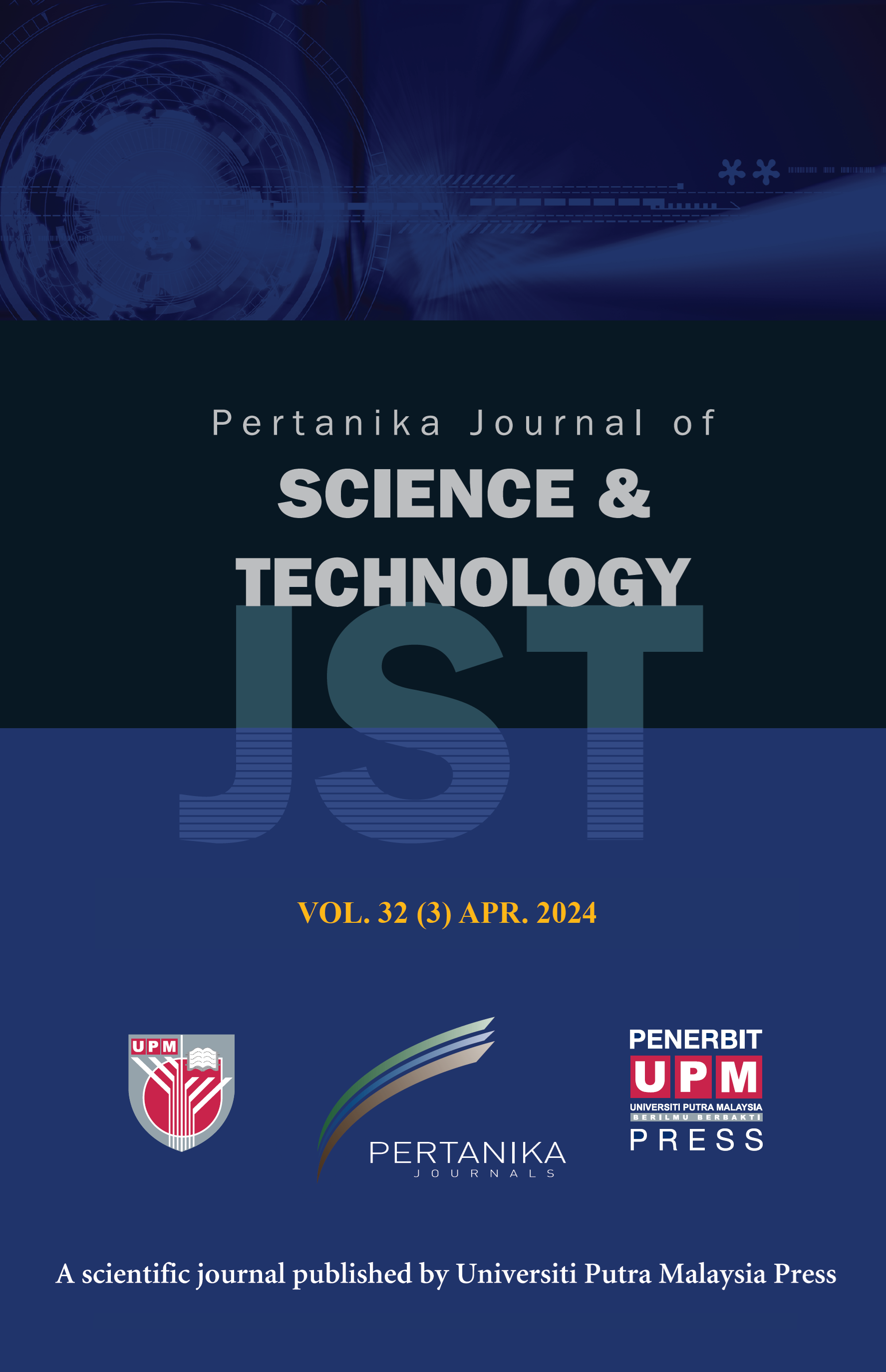PERTANIKA JOURNAL OF SCIENCE AND TECHNOLOGY
e-ISSN 2231-8526
ISSN 0128-7680
Bifurcation Analysis of an Exothermic Biocatalytic Reaction System
'Afifi Md Desa, Mohd Hafiz Mohd and Mohamad Hekarl Uzir
Pertanika Journal of Science & Technology, Volume 29, Issue 1, January 2021
DOI: https://doi.org/10.47836/pjst.29.1.09
Keywords: Bifurcation, biocatalytic reaction, dynamical systems, nonlinear, phase-plane analysis
Published on: 22 January 2021
This paper focuses on the bifurcation analysis of an exothermic biocatalytic reaction system (EBRS). The objectives of the study were to provide a detailed dynamical systems analysis of an exothermic biocatalytic reaction and examine the long-term behaviours of the system using the techniques from phase portraits and bifurcation analysis. We investigated the combined influences of the proportional control constant and dilution rate on the dynamics of the model. Phase portraits relating to distinct outcomes of EBRS were computed to investigate the existence of different attractors in this system and its stability. Under a fixed dilution rate and different values of proportional control constant, there were four distinct outcomes in our model, which were stable steady states, bistability of two stable steady states, bistability between stable steady states and limit cycle and stable limit cycles. A bifurcation analysis (of codimensions one and two) was performed to examine how the overall dynamics change as chemically relevant parameters were varied. We observed that when the values of proportional control constant were high, the system would achieve stable steady states regardless of how fast the dilution rate was. With lower magnitudes of proportional constant control, bistability occurred and the outcomes of this system depended on the initial conditions. Compared to higher dilution rates scenario, reactions that occurred at lower dilution rates provided higher reaction yields for this EBRS operation; it was also observed that both scenarios produced stable steady-state outcomes with different concentrations. In conclusion, the dynamical system analysis of the model improves our understanding of the EBRS under consideration and these insights may be beneficial for optimising operating conditions of this chemical system.
-
Aris, R., & Amundson, N. R. (1958a). An analysis of chemical reactor stability and control—I: The possibility of local control, with perfect or imperfect control mechanisms. Chemical Engineering Science, 7(3), 121-131. doi: https://doi.org/10.1016/0009-2509(58)80019-6
-
Aris, R., & Amundson, N. R. (1958b). An analysis of chemical reactor stability and control—II: The evolution of proportional control. Chemical Engineering Science, 7(3), 132-147. doi: https://doi.org/10.1016/0009-2509(58)80020-2
-
Bommarius, A. S., & Riebel, B. R. (2004). Biocatalysis, fundamentals and applications. Weinheim, Germany: John Wiley & Sons.
-
Choi, J. M., Han, S. S., & Kim, H. S. (2015). Industrial applications of enzyme biocatalysis: Current status and future aspects. Biotechnology Advances, 33(7), 1443-1454. doi: https://doi.org/10.1016/j.biotechadv.2015.02.014
-
De Gooijer, C. D., Bakker, W. A. M., Beeftink, H. H., & Tramper, J. (1996). Bioreactors in series: An overview of design procedures and practical applications. Enzyme and Microbial Technology, 18(3), 202-219. doi: https://doi.org/10.1016/0141-0229(95)00090-9
-
Devasena, T. (2010). Enzymology. New Delhi, India: Oxford University Press.
-
Guan, D., Li, P., Zhang, Q., Zhang, W., Zhang, D., & Jiang, J. (2011). An ultra-sensitive monoclonal antibody-based competitive enzyme immunoassay for aflatoxin M1 in milk and infant milk products. Food Chemistry, 125(4), 1359-1364. doi: https://doi.org/10.1016/j.foodchem.2010.10.006
-
Guengerich, F. P. (2017). Mechanisms of enzyme catalysis and inhibition. In D. L. Eaton (Ed.), Comprehensive toxicology (3rd Ed., Vol. 10-15). London, UK: Elsevier. doi: https://doi.org/10.1016/B978-0-12-801238-3.10922-5
-
Hu, K., Huang, X., Jiang, Y., Fang, W., & Yang, X. (2010). Monoclonal antibody based enzyme-linked immunosorbent assay for the specific detection of ciprofloxacin and enrofloxacin residues in fishery products. Aquaculture, 310(1-2), 8-12. doi: https://doi.org/10.1016/j.aquaculture.2010.08.008
-
Jestin, J. L., & Kaminski, P. A. (2004). Directed enzyme evolution and selections for catalysis based on product formation. Journal of Biotechnology, 113(1-3), 85-103. doi: https://doi.org/10.1016/j.jbiotec.2004.03.032
-
Lindeque, R. M., & Woodley, J. M. (2019). Reactor selection for effective continuous biocatalytic production of pharmaceuticals. Catalysts, 9(3), 1-17. doi: https://doi.org/10.3390/catal9030262
-
Mazzei, R., Giorno, L., Piacentini, E., Mazzuca, S., & Drioli, E. (2009). Kinetic study of a biocatalytic membrane reactor containing immobilized β-glucosidase for the hydrolysis of oleuropein. Journal of Membrane Science, 339(1-2), 215-223. doi: https://doi.org/10.1016/j.memsci.2009.04.053
-
Petkevicius, L., & Baronas, R. (2017, October 8-12). Numerical simulation and analysis of enzyme-catalysed substrate conversion in a microbioreactor. In SIMUL 2017: The Ninth International Conference on Advances in System Simulation (pp. 1-6). Athens, Greece.
-
Petrucci, R. H., Harwood, W. S., & Herring, F. G. (2002). General chemistry: Principles and modern applications (Vol. 1). Upper Saddle River, NJ: Prentice Hall.
-
Radzi, M. R. M., & Uzir, M. H. (2009). Stability study of an exothermic biocatalytic reaction and its application in bioprocess systems. Pertanika Journal of Science and Technology, 17(1), 95-115.
-
Sekhon, J. K., Rosentrater, K. A., Jung, S., & Wang, T. (2018). Effect of co-products of enzyme-assisted aqueous extraction of soybeans, enzymes, and surfactant on oil recovery from integrated corn-soy fermentation. Industrial Crops and Products, 121(December 2017), 441-451. doi: https://doi.org/10.1016/j.indcrop.2018.05.033
-
Tufvesson, P., Fu, W., Jensen, J. S., & Woodley, J. M. (2010). Process considerations for the scale-up and implementation of biocatalysis. Food and Bioproducts Processing, 88(1), 3-11. doi: https://doi.org/10.1016/j.fbp.2010.01.003
-
Uhr, L., Buchholz, T., Homann, T., Huschek, G., & Rawel, H. M. (2014). Targeted proteomics-based analysis of technical enzymes from fungal origin in baked products. Journal of Cereal Science, 60(2), 440-447. doi: https://doi.org/10.1016/j.jcs.2014.04.007
-
Zhao, Y. M., Wang, L. H., Luo, S. F., Wang, Q. Q., Moaddel, R., Zhang, T. T., & Jiang, Z. J. (2018). Magnetic beads-based neuraminidase enzyme microreactor as a drug discovery tool for screening inhibitors from compound libraries and fishing ligands from natural products. Journal of Chromatography A, 1568, 123-130. doi: https://doi.org/10.1016/j.chroma.2018.07.031
ISSN 0128-7680
e-ISSN 2231-8526




